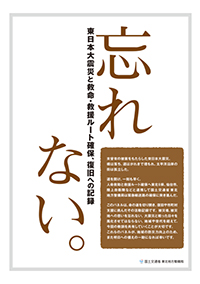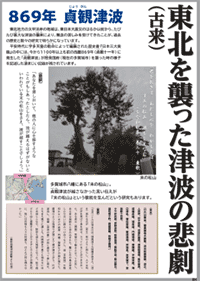Monument
A damaged traffic sign of “Route Number”
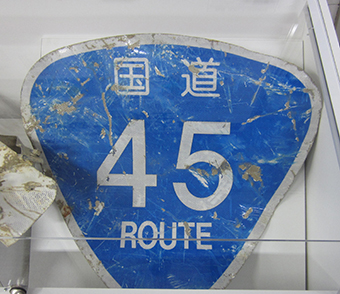
- This is a traffic sign bent by the tsunami.
- Most of traffic signs on Route 45 in the tsunami-stricken area had been swept away.
- The sign post on exhibition was recovered in Minamisanriku of Miyagi Prefecture.
A damaged small sign of “Tsunami Hazard Zone”
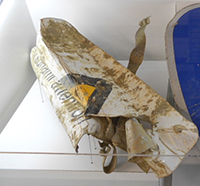
- This is a hazard sign of tsunami installed in a flood-prone area. It was damaged by the tsunami.
- The sign post on exhibition was recovered in Rikuzentakata, Iwate Prefecture.
A delineator post that survived the tsunami

- Delineator posts with reflector are installed at both sides of road at certain interval.
- The delineator on exhibition, which was originally installed along Route 45 in front of the Kesennuma National Highway Maintenance Branch Office, miraculously survived the tsunami, which engulfed the office.
The name plate of the collapsed Utatsu Ohashi Bridge

- The Utatsu Ohashi Bridge on Route 45 (Minamisanriku, Miyagi Prefecture) was engulfed by the tsunami, and its superstructure has been swept away.
- The item on exhibition was the plate of the Utatsu Ohashi Bridge recovered after the tsunami.
A damaged drain pump
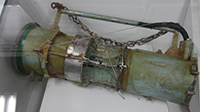
- This is a broken pump of a pumper truck used for drainage of the area flooded by the massive tsunami.
- The pump was broken, because of such a severe operating condition as debris contamination, 24-hour continuous operation in day and night, etc.
A CCTV camera that kept monitoring the tsunami
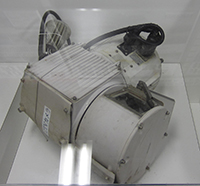
- This is a CCTV camera installed over the mouth of the Abukumagawa River (Terashima area of Iwanuma).
- It kept monitoring the tsunami until the CCTV mounted steel tower was collapsed by the tsunami.
Parts of a damaged water surface cleaning ship
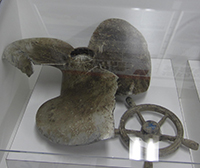
- A water surface cleaning ship moored in the Kitakamigawa River (Ishinomaki, Miyagi Prefecture) was damaged by the tsunami.
- The items on exhibition are a screw and handle of the ship.
Damaged small traffic signs “milespost”
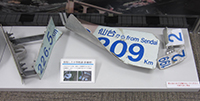
- These are the panels of mileposts bent by the tsunami.
- A milepost shows distance from a starting point of the road.
A “lamp and foundation” of a damaged street light

- This is one of the street lights used in the intersections of the road in the night. The post, foundation, and lamp were torn by the tsunami.
- The items on exhibition were recovered in Miyako, Iwate Prefecture.
An emergency vehicle permit and a relief-supplies sticker

- This is a permit of an emergency vehicle used when we scrambled for the affected area immediately after the earthquake.
A satellite phone delivered to the leaders of the affected municipalities
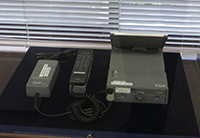
- Communication with the municipalities along the Pacific coast of Tohoku was completely disrupted immediately after the earthquake.
- The first thing the liaisons did when they arrived at the affected area after the road clearance was to deliver satellite phones to the leaders of the municipalities.
- The item on exhibition was the satellite phone actually delivered to Tanohata of Iwate Prefecture.
- ◆Satellite phone
- ・A telephone device which can directly access the satellite for communication
- ・Even if you are out of range of the conventional mobile phone network or there is no relay station, you can call anyone.
A shovel delivered to Higashimatsushima

- The shovel on exhibition was one of the 600 shovels delivered to Higashimatsushima (Miyagi Prefecture) by the request of the city.
- They were used by local residents and volunteers to clear debris in the buildings affetced by the tsunami, restore the roads, or clearn out the ditches.
A “melodica” of Unosumai Elementary School
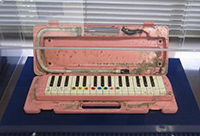
- The tsunami that struck Unosumai Elementary School in Kamaishi, Iwate Prefecture reached the third floor of the school building.
- The “melodica” on exhibition, actually used in a classroom, was given to this exhibition.
※Although Unosumai Elementary School was struck by the tsunami, all the students present safely evacuated immediately after the earthquake and no casualties were reported.
A “clock” of Unosumai Elementary School
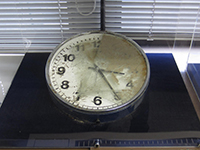
- The tsunami that struck Unosumai Elementary School in Kamaishi in Iwate Prefecture reached the third floor of the school building.
- The “clock” on exhibition, actually used in a classroom, was given to this exhibition.
※Although Unosumai Elementary School was struck by the tsunami, all the students present safely evacuated immediately after the earthquake and no casualties were reported.
A damaged road patrol car

- This is a road patrol car used for the road maintenance and surveillance of Route 45 by the Kesennuma National Highway Maintenance Branch Office in Miyagi Prefecture.
- Although the Kesennuma National Highway Maintenance Branch Office was struck by the tsunami, all the staff safely evacuated immediately after the earthquake and no casualties were reported.

